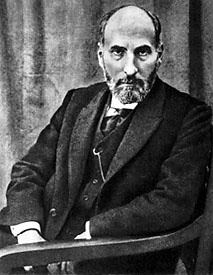Ramón y Cajal, Santiago
Spanish histologist
born May 1, 1852, Petilla de Aragón, Spain
died Oct. 17, 1934, Madrid
 Spanish histologist who (with Camillo Golgi (Golgi, Camillo)) received the 1906 Nobel Prize for Physiology or Medicine for establishing the neuron, or nerve cell, as the basic unit of nervous structure. This finding was instrumental in the recognition of the neuron's fundamental role in nervous function and in gaining a modern understanding of the nerve impulse.
Spanish histologist who (with Camillo Golgi (Golgi, Camillo)) received the 1906 Nobel Prize for Physiology or Medicine for establishing the neuron, or nerve cell, as the basic unit of nervous structure. This finding was instrumental in the recognition of the neuron's fundamental role in nervous function and in gaining a modern understanding of the nerve impulse.Ramón y Cajal obtained a medical degree at the University of Zaragoza in 1873 and became an assistant in the medical faculty there two years later. He served as professor of descriptive anatomy at the University of Valencia (1884–87) and professor of histology and pathological anatomy at the universities of Barcelona (1887–92) and Madrid (1892–1922). He improved Golgi's silver nitrate stain (1903) and developed a gold stain (1913) for the general study of the fine structure of nervous tissue in the brain, sensory centres, and the spinal cords of embryos and young animals. These nerve-specific stains enabled Ramón y Cajal to differentiate neurons from other cells and to trace the structure and connections of nerve cells in gray matter and the spinal cord. The stains have also been of great value in the diagnosis of brain tumours.
In 1920 King Alfonso XIII of Spain commissioned the construction of the Cajal Institute in Madrid, where Ramón y Cajal worked until his death. Among his many books concerning nervous structure is Estudios sobre la degeneración y regeneración del sistema nervioso, 2 vol. (1913–14; The Degeneration and Regeneration of the Nervous System).
- Nicolás de Ovando
- Nicolás Guillén
- Nicomachus of Gerasa
- Nicomachus of Thebes
- Nicopolis Actia
- Nicopolis, Battle of
- Nicosia
- nicotine
- Nicoya, Gulf of
- Nicoya Peninsula
- Nicéphore Niépce
- Niderviller ware
- Nidularium
- Nidwalden
- Niebuhr, Barthold Georg
- Niebuhr, Carsten
- Niebuhr, Helmut Richard
- Niebuhr, Reinhold
- Niedere Tauern
- Niederösterreich
- Niel, Adolphe
- Niel Gow
- niello
- Niels Bohr
- Nielsen, A.C.